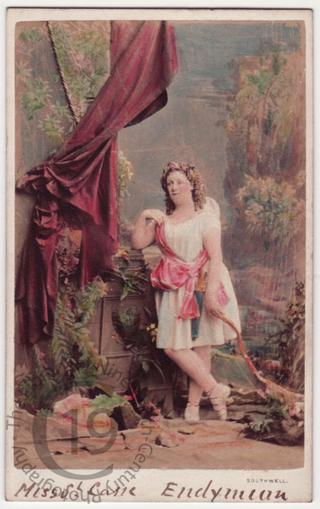
Clara St Casse as ‘Cupid’
A carte-de-visite portrait of the British actress Clara St Casse, seen here dressed as ‘Cupid’ in William Brough’s Endymion, or, The Naughty Boy who Cried for the Moon, in which she appeared at the Royal St James’s Theatre in December 1860 and March 1861.
According to a review of the ‘new classical mythological extravaganza’ in The Times (27 December 1860): ‘Mr W. Brough has founded his play upon the legend of Endymion, the Shepherd Prince, whose love for Diana or the Moon has been familiarized to English readers by Keate’s exquisite poem. When as Luna the Goddess of the Silver Bow (Miss Herbert) ascends the skies, riding in her crescent moon, her rays fall on the beautiful youth Endymion (Miss M. Taylor), who is sleeping on the summit of Mount Latmos. She descends and kisses him. It is natural that he should awake, and that he should behold in the goddess the bright being he has long dreamed of. Diana, however, leaves him in a state of profound melancholy, which he cannot overcome, even when he appears, as in the opening of Keate’s poem, monarch of the shepherd festival, held in honour of Pan, the tubelary deity of the foresters and shepherds. His constancy is eventually rewarded by the appearance of the goddess, who conveys him to her home in the clouds, in a scene remarkable for its chaste beauty. These are the main incidents of the plot, with which, however, many mythological incidents are incorporated. Diana’s favourite nymph, Arethusa, is pursued by the river god Alphaeus, to the terror of her sister nymphs. Cupid, too (Miss St Casse), enters the hunting grounds of Diana, and, to the great delight of Pan and his attendant satyrs, who have long been dying of love of Diana and her nymphs, discloses his design of wounding them with his dart. Actaeon (Mr C. Young), a modern sporting man, is, of course, transferred into a stag and pursued by his own hounds. Our author here, leaving Ovid, resorts to Shakespeare, and in a series of scenes suggested by Titania and Bottom Diana is made to fall in love first with Pan (excellently acted by Mr Belmore) and afterwards with the antlered Actaeon. Cupid, however, does not fail to counteract his own spell in due time, and the motto that true love should be confined to one object alone is inculcated in Diana’s constancy to Endymion. Alphaeus is pardoned and united to Arethusa, Actaeon is consoled by the goddess’s present of all her hunting grounds, and Enymion ascends, as we have said, with his goddess amid universal happiness. The extravaganza contains some ingenious puns and allusions. Miss M. Taylor, Miss St Casse, and Mr C. Young sing several songs adapted to popular melodies, while the classical poses and spirited acting of Miss Herbert as Diana contributed greatly to the success of the piece and its favourable reception.’
Photographed by the Southwell Brothers of London.
Code: 124475




